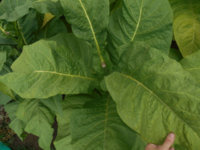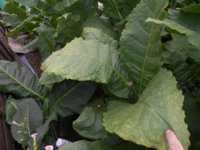It doesn't really fit the standard definition of a bright leaf or a burley
As humans, we are plagued by what is called, "categorical perception." Is the color teal "green" or "blue"? My computer graphics card has no problem with there being millions of colors, but my brain insists on categorization. Is khaki "brown" or "green". A rainbow is a continuum of visible colors, yet we identify: red, orange, yellow, green, blue, indigo, violet. Our brains are too busy with other stuff to voluntarily attend to nuance.
When it comes to USDA ARS-GRIN market class, we name where and how a particular strain of tobacco was generally utilized by the American tobacco industry during the late 19th century.
What? That's how, for example, we ended up with Dark Fire-Cured
and Dark Air-Cured as separate market classes. They are both the same general sort of tobacco plants (large, thick, sticky, and very "hairy" leaves), but some US tobacco growing regions that grew them were chronically too humid during the
curing season, so the growers prevented them from molding by maintaining low fires in the curing barn—to raise the temperature and thereby lower the humidity. It had nothing to do with the biology of those tobacco plants. (Had the market classes been named a few decades later, they might have been called "Dark Electricity-Cured" and "Dark Naturally-Cured.")
When it comes to burley vs. flue-cured, many burley varieties don't flue-cure well, because they need more time than just their yellowing time to get rid of their higher protein and carb burdens. Flue-cure varieties have more sugar to start with. But among the thousands of known tobacco varieties, it's a continuum. Is teal "green" or "blue"? We nudge the end product by how we go about curing it, and also by how we mentally categorize it.
Symbol 4 is a great example. Its pedigree clearly includes a "Virginia" variety. If the protein and carbohydrate levels (and burley-specific volatile flavors) are in between, it becomes more like a pre-blended, burley-Virginia blend. (The Soviet tobacco industry was big on efficiency. Why blend the tobacco, when you can blend the plant's inheritance?)
Sorry,
@furryfreek, for the long-winded diversion.
Bob


















